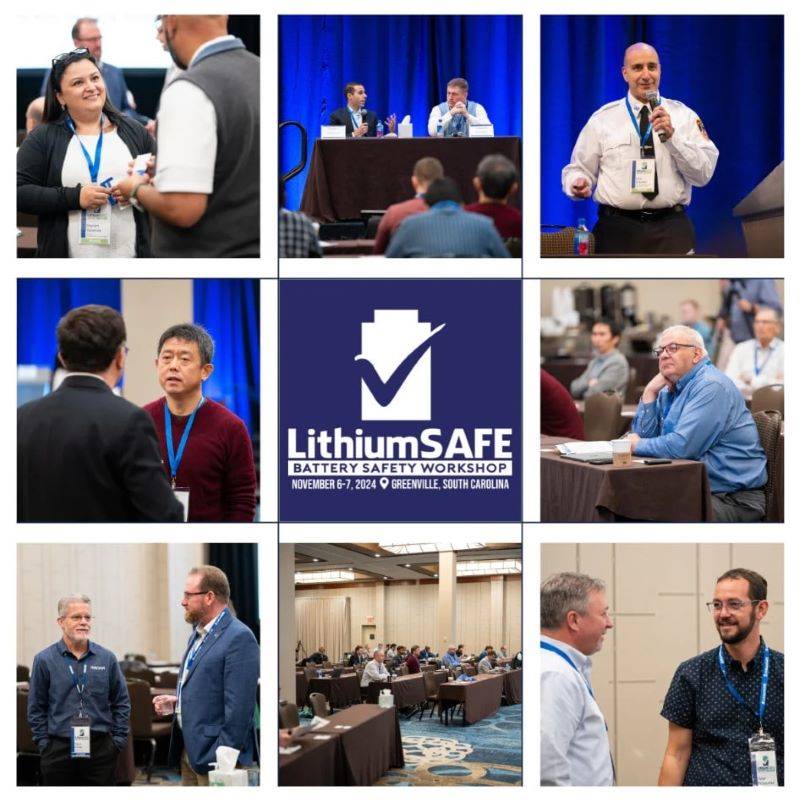As part of our LithiumSAFE Conference, we held a panel on how to speak about battery safety in the marketplace. Panelists included Jim Greenberger, Executive Director of NAATBatt, Brian Engle, Director of Business Development at Amphenol, and John Warner, Chief Customer Officer at American Battery Solutions.
In addition, we had two keynote presentations, one by John Orlando of the New York City Fire Department, and the other by Rob Rezende, from San Diego Fire and Rescue. During each of their presentations, they showed videos and pictures of battery fires that were caught on security cameras. Seeing the videos of live, in-the-field explosions of lithium-ion batteries gave me and the other attendees a real sense of what we are dealing with as an industry.
Rob Rezende described his fire fighters as having to consider anything that may hold a lithium-ion battery as unexploded ordinance (ammunition) that could go off unexpectedly when they are in a building trying to fight the fire or rescue inhabitants. It is possible that a lithium-ion battery could explode and ignite a portion of a room, cutting off their exit path and leaving them trapped. This changes everything about how they now deal with fires, because batteries are so prevalent in different devices throughout the home. Think of being a fireman in full gear, walking through a house searching for a child who might be stranded, and then your path to leave (and rescue the child) is cut off by the battery from a drill, power tool, toy or computer which explodes behind you and ignites the exit path. It’s a bit terrifying.
But on the other hand, most lithium-ion batteries are built very well, and battery fires are quite rare. About one in 5,000,000 cell phones and computers will spontaneously ignite. Instances of fires in power tools are also quite rare, and spontaneous fires in electric vehicles are rare, even if they have resulted in a several recalls by the OEMs who are, in my opinion, being quite responsible in their judgment to recall the batteries.
E-bikes and scooters, on the other hand, appear to have a fire rate that is around 1 in 1,000, but that likely varies a lot depending on the manufacturer. Unfortunately for now, there is no way for a consumer to tell if an e-bike is equipped with a battery that would have a high probability of fire or a low one. We’re addressing this in our e-bike project and expect to publish a complete report in the first quarter of 2024.
So where does this lead those in the industry, who want to be truthful and accurate in describing the risks, but do not want to go to the side of fearmongering or creating hysteria? Underplaying it would slow down the efforts to address the issues. Overplaying it will slow down the growth of the market, which we all enjoy.
Having mulled this question over for a couple weeks since conference, it appears quite simple—we tell the truth. Don’t be afraid of your devices because fires are quite rare. But when one happens, please get away quickly, because they are also very ferocious, and can block an exit path within seconds and ignite a large building fire soon thereafter.
When you think about them this way, some actions become obvious. Advanced warning systems can help people get to safety quickly and may also be able in some instances to prevent the fire altogether. We applaud the work done by Amphenol, Honeywell, Nexceris and others to provide the tools that will enable this, and of course the LIB Fire Alarm System we announced last week will hopefully play a big role.
Another way to mitigate the risk is through the placement of the batteries, either geographically or strategically within the home. Thus, a detached garage is a good place for your power tools, scooters, e-bikes and lawn and garden tools. Home energy storage should be away from the house. EV chargers might be under an open carport, in a detached garage, or in the driveway (where mine is).
For small devices, several companies are also presenting containers that the batteries can be placed in while charging. Cellblock, LithiumSafe Battery Box, Bat-Safe and Pulse Battery Charging Safe Box are examples of these. Bridgehill and Brimstone Fire Protection have also presented a blanket that can be placed over a battery fire to smother it and prevent it from spreading.
There will be other innovations also, perhaps requiring the use of concrete wallboard in garages, or special fire extinguishers or water misters or other extinguishing systems. There may be new flame-retardant materials developed that are particularly effective against lithium-ion battery fires. Other innovations within the battery itself, like our separator and current collectors, will reduce the risk of fires. Other innovations may reduce or direct the energy that comes from the battery fires.
When you recognize that battery fires are rare, but ferocious, and focus safety technology on making them rarer, and reducing either the ferociousness itself or the effects of the ferociousness, specific innovations like those mentioned above will come to mind. Congratulations to those whose mental wheels are already spinning!
